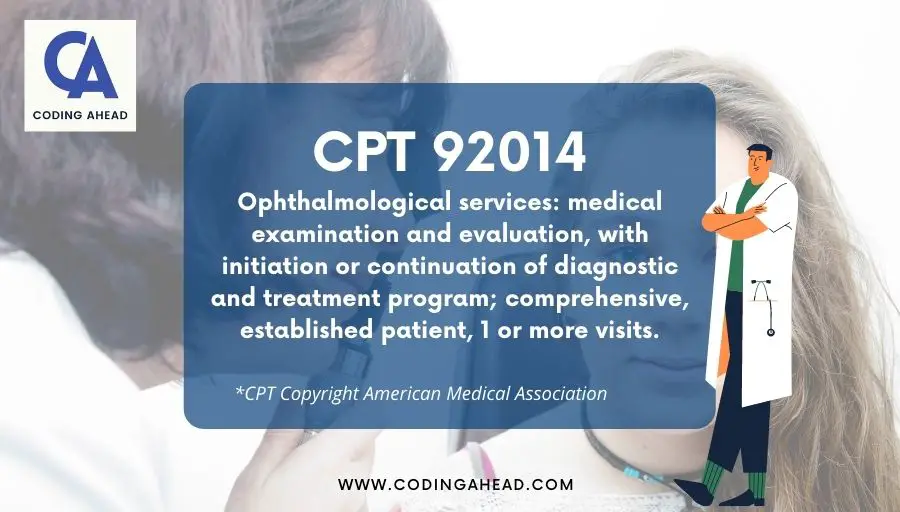(2022) CPT Code 92014 – Description, Guidelines, Reimbursement & Modifiers
CPT code 92014 provides a detailed overview of the whole visual system of the patient. The 92014 CPT code includes a complete history, an overview of general health, and a thorough ophthalmoscopic inspection.
The Procedure
CPT Code 92014 can be billed for the following procedure. A physician must analyze the optical system and thoroughly review the patient’s record. In addition, they need to implement medical expertise related to diagnosing peripheral and ophthalmoscopic evaluation.
Unorganized and simple practices with sensory-motor evaluation are also investigated, which involves the bio-microscopy investigation concerning cycloplegia (paralysis of the ciliary muscle, causing a loss of accommodation) or mydriasis (dilation of the pupil in response to light), and tonometry.
Detailed evaluation and management that solely depend upon orientation and persistence also involve other techniques such as corneal sensitivity, slit lamp viewing, tear testing, retinoscopy, exophthalmometry, fundus examination, keratometry, and corneal staining.
More than one patient visit will be required to fulfill the medical necessity of CPT code 92014.
Description Of CPT Code 92014
CPT code 92014 is used to get a detailed overview of the patient’s visual system. It also includes an overview of general health, a complete history, and a thorough ophthalmoscopic inspection.
The official description of CPT code 92014 is: “Ophthalmological services: medical examination and evaluation, with initiation or continuation of diagnostic and treatment program; comprehensive, established patient, 1 or more visits.”

The 92014 CPT code also involves the general evaluation of sensory-motor that is carried out by the investigation at the microscopic level, e.g., in the case of cycloplegia (paralysis of the ciliary muscle, causing a loss of accommodation) or mydriasis (dilation of the pupil in response to light), and tonometry.
CPT 92014 almost invariably entails the start of diagnostic and therapeutic procedures.
A complete eye exam also requires gross visual fields and a basic sensory-motor test. Dilation is not a treatment that is allowed to code because it is included in the code narrative.
General medical observation is a component of data frequently absent in an eye examination medical record classified for the 92014 CPT code. Witnessing the patient delivers valuable information about the patient’s overall medical condition.
Written notes on physical characteristics and symmetry, emergence, bulk, skin shade, occurrence and capacity of inhalations, hair dispersal, and scents are used to document universal therapeutic interpretations.
CPT code 92014 cannot be classified without proof of primary care assessment. Descriptions on the internal analysis in the specification could be included in evidence enabling the coding and billing of CPT 92014.
A basic verification rule is that whatever wasn’t written didn’t happen. Modestly add criteria to resolve the problem. To fulfill the standard, you should start a standard treatment regimen that incorporates drugs imposed by law and demands authorization.
Acquiring over-the-counter medicines with the 92014 CPT code for a patient is unacceptable.
Billing Guidelines
Several health coverage packages provide one regular office visit annually for CPT code 92014, and diagnostics classifications for astigmatism, nearsightedness (known as hypermetropia), distortion, and refractive errors are frequently covered.
Health coverage normally wages more than optical insurance. Therefore, if the patient is comprehended for a regular eye inspection and the assessment is covered by health insurance, you should use CPT code 92014 as medical instead of optical.
Don’t charge CPT 92014 combined optical and medical coverage for the identical treatment at the same interval.
Before going to the local clinic, double-check the medical and vision plans; print or duplicate both pages of the credentials if you require a pre-approval ID to see a patient.
Double-check the insurance policy for the previous authorization number. POS and PPO users who use their illegal benefits to seek regular or optometry medical care outside the EyeMed Vision Care network may be charged for a suitable payment portion.
A rising Medicare operation is a cataract procedure including an intraocular lens (IOL) implant.
A wide variety of diagnostic studies are offered to the physician in addition to the procedure.
A regular eye inspection (visual background and ocular assessment) and a brief image to identify the optimal pseudo-phakic intensity of the IOL (intraocular lens) seem preferable in most situations.
A diagnostic ultrasonography A scan is employed in most instances with simple glaucoma. In addition, an ultrasound B-scan may be performed for individuals with thick astigmatism.
As a result, if the sole diagnosis is cataract, Medicare somehow doesn’t fund screening apart from a single complete annual exam (or combination of a detailed outline and an A-scan, as well as medically indicated, a B-scan) and an A-scan or, if medically supported, a B-scan.
Even if there is an appropriate CPT 92014 assessment and the professional requirement for further investigations is adequately proven, claims for further investigations are refused as not reasonable and required.
Although surgical treatment is optional, the individual can choose whether to postpone the procedure or have it performed by a professional other than the one who diagnosed them.
Sometimes a second assessment by the performing specialist may be medically necessary.
Billing Instructions for Providers
CPT code 92014 must be invoiced with the following evaluation and management codes:
- standard ophthalmological therapies;
- office or other outpatient treatment;
- office or other outpatient assessment; and
- emergency department facilities.
Establish the compensatory lens polarization state. Use the CMS 1500 (02/12) request template to bill procedures. Should utilize Medicare Advantage PPO reporting criteria that are particular to Medicare.
CPT/HCPCS codes and diagnostic codes should always be documented to the utmost degree of detail achievable. Including all submissions, provide your National Provider Identifier (NPI) information.
Seek compensation with your Blue Cross plan in your area. Determine the refractive status of the body to rule out trauma, sickness, or infection.
Standard ophthalmological scrutiny must be invoiced, which displays the transmittance. CPT code 92014 is not a differentiated procedural code that may be submitted.
Therefore, it is necessary to charge the minimally invasive surgical code. CPT code 92014 is not reportable since it is deemed unrelated or mutually exclusive.
The ophthalmological inquiry CPT code 92014 is payable with CPT 92225 and CPT 92226. Reciprocal ophthalmoscopy, which may not require an illustration, may not be invoiced independently and is included in a routine ophthalmologic evaluation (92002 – 92014).
To submit a thorough eye session code, individuals must first consider how many exam items they accomplished.
Focal length, Broad ocular regions, Oculomotor reflexes, Conjunctiva, Retinal adnexa, Ocular and pupil, Retina, Choroid, Lens, Glaucoma, and Ganglion cell cassettes are among the evaluation parts.
Dilation of the cornea and arteries, whenever medically indicated and registered in the record in contrast to the preceding, you must record the beginning of the screening and therapeutic procedure.
If an extensive follow-up consultation (CPT 92014) with the same prognosis or disease as additional standardized ophthalmologic treatment is reported in less than six months, procedures involving radiography and clinical information may be required.
How To Use Modifiers With The Modifier 92014 CPT Code
CMS has reinstated the NCCI modifications to CPT code 92012 and CPT code 92014.
The alterations, based on CMS global surgery guidelines for filing evaluation and management (E/M) codes on the same treatment date as a global surgery performed, bundle CPT codes 92012 and 92014 (recognized patient retinal codes) into global surgery procedures.
CMS had formerly grouped this CPT code under global surgical procedures.
Still, somehow the amendments were halted because a few MAC claims handling methods did not grant modifiers 24, 25, or 57 to be included in CPT 92012 and 92014.
The MAC processing systems enable those three modifiers to CPT codes 92012 and 92104.
As a result, CMS will again apply these adjustments with retroactive effect when MAC processing systems are required to enable modifiers 24, 25, and 57 with Codes 92012 and 92014. Therefore, any claims received on or after July 1, 2014, including operation durations, are not eligible.
Recognize that only E/M care can be documented on the same day as a major surgical operation (within a 90-day billing cycle) if the E/M service causes the conclusion to execute the surgery.
The E/M code would’ve been modified with the modifier 57. Whenever an E/M service is substantial and distinctly recognizable on the same day as the procedure for minor invasive procedures (global time of 0 or 10 days), it is independently notifiable on the same day as the treatment.
The choice to undertake a minimal surgical operation will not be the main reason for reporting an E/M service.
Modifier 25 denotes a major and unique E/M service.
Modifier 24 suggests that because an unassociated service was offered by a particular general practitioner or another certified healthcare worker even during the postsurgical global clinical timeframe of a major or minor protocol when attached to an evaluation and management (E&M) or eye examination code (CPT codes 99201 – 99499, 92002 – 92004, and 92012 – 92014).
Throughout the subsequent global surgical interval of significant or minor surgery, the diagnostic code filed with the E&M or eye examination service should establish that the E&M service or eye examination was unrelated to the surgical process.
Modifier 24 advantages must be well in the patient record to demonstrate that the interaction was unrelated to the condition that caused the session.
The procedure was essential and must not add modifier 24 on an E&M encounter or eye exam service related to a surgical complication or infection which does not require a ride back to the Hospital Setting or for the abolishment of dentures or other wound treatments which are all supposed to be part of the global surgical packs.
For further information, see the “Global Surgery” procurement policy. In addition, modifier 24 should not be applied to an E&M appointment or eye assessment that occurs except in a preceding major or minor procedure’s post-operative global surgical interval.
Reimbursement
Diagnostic checks for CPT code 92014 are reimbursed to the extent deemed appropriate and required by A/B Medicare Administrative Contractor (MAC) health workers.
Participants must file a petition and pay for members who might have an ophthalmic premium.
If individuals charge a member for prescription glasses, they charge the eyewear separately from the eye test. When charging for any eyeglasses, mention your optician’s NPI.
The contracted optometrist’s NPI should be included for invoicing an examination.
Eye examinations and eyeglasses claims must be invoiced on respective claim forms, as Blue Cross shows.



